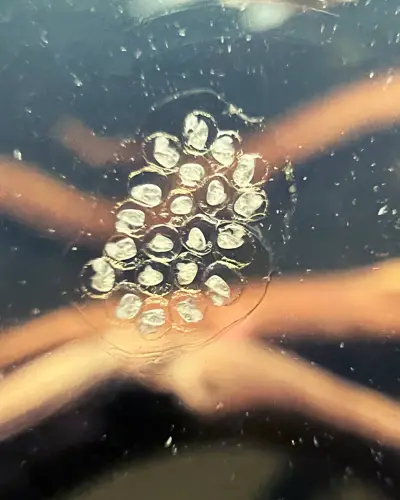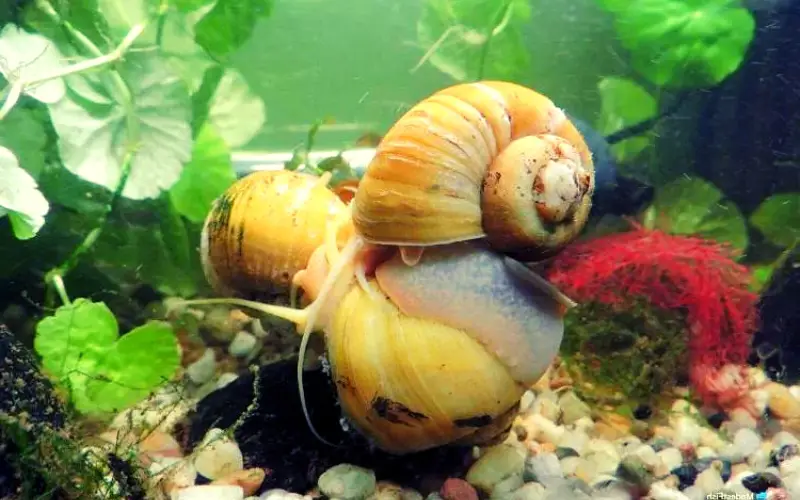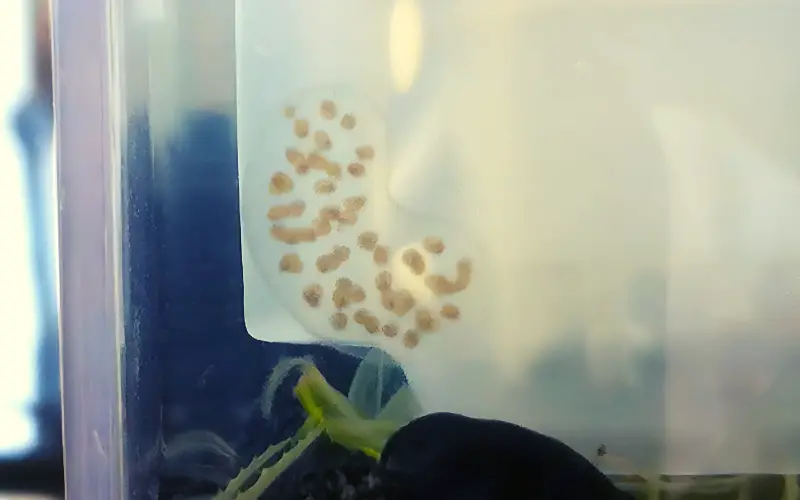Ramshorn snails are popular among many aquarium enthusiasts due to their unique appearance and beneficial scavenging behavior. One fascinating aspect of these snails is their ability to reproduce quickly by laying eggs. This comprehensive guide will explore everything you need to know about Ramshorn snail eggs.
From the different types of Ramshorn snails that lay eggs to the optimal conditions for successful hatching, we will cover all the essential information for beginner and experienced aquarists alike.
Whether you are interested in breeding Ramshorn snails in your aquarium or want to learn more about these intriguing creatures.

This article will provide all the facts and tips you need to ensure a successful egg-laying and hatching process. Join us as we delve into the world of Ramshorn snail eggs and unravel the mysteries of their reproduction cycle.
Table of Contents
ToggleWhat is the Freshwater Snail Breeding Process Like?
Freshwater snail breeding involves a simple and fascinating process. Ramshorn snails, a hardy species of snail, spend most of their time grazing on algae and uneaten food in the aquarium.
They will also eat mystery and other snail eggs that may be attached to surfaces. Ramshorn snails lay their eggs in clusters, each laying up to a dozen of ramshorn eggs per day. If not controlled, the snail population can quickly take over an aquarium.

Owners of ramshorn snails need to remember that ramshorn snails are not picky and will also feed on fish in the aquarium. To prevent overpopulation, it is essential to remove the ramshorn snails eggs around the tank regularly.
In addition to ramshorn snails, mystery snails can reproduce rapidly, so monitoring the snail population closely is crucial.
The freshwater snail breeding process can vary depending on the specific species. Here’s a general overview of the two main reproduction methods:
Hermaphroditic Snails:
- Most common: This applies to species like Ramshorn, Bladder, and Mystery snails.
- Self-fertilization: They possess both male and female reproductive organs, allowing them to fertilize their eggs.
- Egg-laying: Females deposit jelly-like egg masses on surfaces like plants, rocks, or the aquarium glass.
- Large clutches: The number of ramshorn eggs per clutch varies, but it can range from a few dozen to hundreds.
- Independent development: Hatchlings emerge fully formed and fend for themselves.
Ramshorn Snail vs Mystery Snail
Ramshorn snails and Mystery snails are widespread in freshwater aquariums but have some key differences. Here’s a comparison to help you decide which one is right for you:
Size:
- Ramshorn Snail: Up to 1 inch long (2.5 cm) in diameter
- Mystery Snail: Up to 2 inches (5 cm) in diameter
Appearance:
- Ramshorn Snail: The Shell has a spiral shape with a flat base and a pointed tip. Colors can vary from brown to red to green.
- Mystery Snail: The Shell has a more rounded shape and smooth surface. Colors can be brown, black, yellow, or even olive green.
Diet:
- Ramshorn Snail: Mainly eats algae but will also consume detritus and biofilm.
- Mystery Snail: Eats algae, biofilm, detritus, and some live plants.
Reproduction:
- Ramshorn Snail: Reproduces asexually and can quickly become overpopulated if not controlled.
- Mystery Snail: Reproduces sexually and requires a male and female to breed.
Temperament:
- Ramshorn Snail: Peaceful and unlikely to bother other tank mates.
- Mystery Snail: Generally peaceful but may occasionally eat small shrimp or snails.
Other:
- Ramshorn Snail: Can tolerate a broader range of water parameters than Mystery Snails.
- Mystery Snail: Can escape from open-top tanks due to their ability to breathe air.
Which one is right for you?
- If you have a small tank or are worried about overpopulation, the Ramshorn snail is a good choice.
- The Mystery Snail is a good option if you want a larger snail with more personality.
- If you have live plants, choose a snail not known to eat them, such as the Ramshorn snail.
Ultimately, the best snail for your aquarium is the one that best suits your needs and preferences.
Role as Aquarium Pest: Controlling Ramshorn Eggs
Red ramshorn snails are considered a pesky aquarium pest because of their ability to reproduce rapidly. They lay their clusters of eggs in small, transparent capsules that can easily blend in with the aquarium plants and decorations in your tank.
These eggs will hatch into new snails if unchecked, creating a population explosion. However, nerite snails can be a helpful tool in controlling the growth of ramshorn snails in your tank.
These snails will eat the eggs and young snails, preventing them from overrunning your aquarium. Additionally, nerite snails provide natural beauty and movement, making them a great addition to your aquarium.
Ramshorn snails are hardy and can survive in various water conditions, making them difficult to eradicate once they have established a population in your tank. Furthermore, ramshorn snails can breed with other snail species, further complicating matters.
To keep ramshorn snails under control, it is important to regularly remove any visible clusters of eggs and provide plenty of hiding places for your snails. Doing so will help prevent a population explosion and maintain a healthy balance in your tank.
What Do Ramshorn Snail Eggs Look Like?
Ramshorn snail eggs are tiny, jelly-like capsules in clusters around the aquarium. Ramshorn snails lay many clusters of eggs, each containing around a dozen. These eggs can hatch in just a few weeks, depending on the water temperature and conditions.
In terms of appearance, ramshorn snail eggs are translucent and can blend in with the sides of the tank. If not removed, the ramshorn snails eggs will hatch, and the baby snails will quickly grow in number.

Ramshorn snails can also be found in various colors, adding to the aesthetic appeal of the tank. In addition to the home aquarium, these snails can also be beneficial for algae control. Ramshorn snails seem to enjoy feeding on algae and decaying plant matter.
However, monitoring the population is essential as snails can quickly reproduce from snail to snail. Try to scour your aquarium for algae and food to prevent overpopulation.
On the other hand, some aquarium fish may see them as a tasty snack, so it’s important to provide hiding spots for the snails to avoid being eaten. Overall, there are many great things about ramshorn snails for hobbyists and the tank’s ecosystem.
Ramshorn Snail Breeding
Ramshorn snails are popular freshwater aquarium snails known for being prolific breeders. They are hermaphroditic, meaning they have both male and female reproductive organs to reproduce independently or with another snail.
Ramshorn snails lay eggs in clutches of 10-20, and the ramshorn eggs will hatch in about 2-3 weeks. The young snails will be tiny but grow quickly and reach maturity in about 3-4 months.
If you are interested in breeding Ramshorn snails, there are a few things you can do to encourage them. First, make sure that they have plenty of food to eat.
Ramshorn snails are scavengers that eat algae, detritus, and other leftover food. You can also supplement your diet with blanched vegetables like spinach or zucchini. Second, make sure that the water quality in your tank is good.
Ramshorn snails are sensitive to ammonia and nitrite, so it is essential to test your water regularly and make water changes as needed. Finally, please provide them with plenty of hiding places. Ramshorn snails are shy creatures and will be more likely to breed if they feel safe.
If you have too many Ramshorn snails in your tank, there are a few ways to control their population. You can manually remove some snails or add predators, such as loaches or puffers. You can also reduce the amount of food available to them, slowing their reproduction rate.
Here are some additional things to keep in mind about Ramshorn snails:
- They are relatively peaceful creatures and will not harm other fish or invertebrates.
- They are good at cleaning up algae and residue, which can help improve your tank’s water quality.
- They can be a nuisance if their population gets too large.
Overall, Ramshorn snails are relatively easy to care for and breed snails that can be valuable to a freshwater aquarium. However, it is crucial to be aware of their potential to overpopulate your tank and to take steps to control their population if necessary.
How to Take Care of Ramshorn Baby Snails
Ramshorn baby snails can benefit your aquarium as they help keep the tank clean by consuming algae and waste. To take care of these tiny snails, it is essential to protect the eggs and anchor clusters of eggs appear around your aquarium.
Ramshorn snails lay several clusters of eggs, each containing around a dozen transparent snail eggs inside of the tank. These eggs will eventually hatch, and the snails will also eat Ramshorn snail eggs that may not hatch.
To ensure the reproduction of Ramshorn snails, kill any Ramshorn snail eggs that may not be viable. Remember that other species of snails will also eat Ramshorn snails, so monitoring the population in your tank is essential.
Ramshorn snails can survive in various water conditions and coexist peacefully with most fish in your aquarium.
Commonly Asked Questions about Ramshorn Snail Eggs (FAQs)
How fast do ramshorn snails reproduce?
Ramshorn snails reproduce impressively quickly! They reach maturity in just 4-6 weeks and lay egg clutches regularly, each containing around a dozen ramshorn snails eggs. These hatch within 2-4 weeks, leading to rapid population growth. Be mindful of adding them to your tank!
How often do ramshorn snails lay eggs?
Ramshorn snails are prolific breeders, laying egg clutches frequently, sometimes even daily! Each clutch boasts a dozen rams horn eggs, hatching in 2-4 weeks. Manage their population in your tank if needed.
Do ramshorn snails eat fish eggs?
Ramshorn snails might nibble fish eggs but mainly target dead or fungus-infected ones. They can even benefit from frying by cleaning debris. However, for guaranteed egg survival, separate breeding tanks are safer.
How long do ramshorn snail eggs take to hatch?
How long for ramshorn snail eggs to hatch? Depending on water temperature, Ramshorn snail eggs hatch in 2-4 weeks. Watch for “fuzzy” eggs – that’s baby snails breaking out! Keep an eye on populations as they reproduce frequently.
Do ramshorn snails eat their eggs?
Yes, ramshorn snails occasionally munch on their own eggs, especially in crowded tanks. Ensure ample food and space to discourage this “snacking on mystery snail eggs” and boost baby snail survival.
How fast do ramshorn snails grow?
In term ramshorn snail growth, Rams horn snails are speedy growers! Reaching adult size in just 4-6 weeks. Be mindful that this quick growth can lead to population blooms if unchecked.
How many babies do ramshorn snails have?
Ramshorn snails lay clutches of around 12 eggs at a time, but they reproduce frequently, so the babies add up quickly! Be prepared for a mini snail boom!
How do you encourage ramshorn snails to breed?
Ramshorn snails breed readily without encouragement! Maintain good water quality with moderate food (algae, veggies) and calcium for strong shells. They’ll do the rest, sometimes too well! Monitor population if needed.
Conclusion
When clusters of ramshorn snail eggs appear in your aquarium, it is vital to consider the implications. With each species of ramshorn snail capable of laying a dozen eggs around your aquarium, the population can quickly grow out of control. These ramshorn eggs will eventually hatch from their eggs, leading to more snails in your tank. While ramshorn snails will eat algae in your tank, they can also become a nuisance if left unchecked. If you have a community tank with ramshorn snails, be cautious, as they may eat them or their eggs. Consider providing alternative food sources, such as feeding your aquarium fish, to prevent the snails from overpopulating and causing harm to your tank.
You might also like
- Ramshorn Snails: Tiny Tank Titans or Tidal Wave of Trouble?
- Do Ramshorn Snails Eat Plants in Aquarium: (Myths & Facts)
- Are Ramshorn Snails Asexual Reproduction?
- Ramshorn Snails Size 101: Expert Aquatic Snails Caring Guide
- Ramshorn Snails Colors 101: Plant Friendly Tank Additions
- Decoding Bladder Snails Eggs: A Comprehensive Care Manual
- Ultimate Guide to Ramshorn Snail Reproduction in Home Aquarium
- How Often Do Ramshorn Snails Lay Eggs in Aquariums: Explained
- Identifying Ramshorn Snail Babies in Your Tank (Proven Tips!)
- Freshwater Aquarium Snail Eggs on Glass: What You Should Do?
- Identifying Freshwater Snail Pond Snail Eggs in Aquarium: Comprehensive Guide




